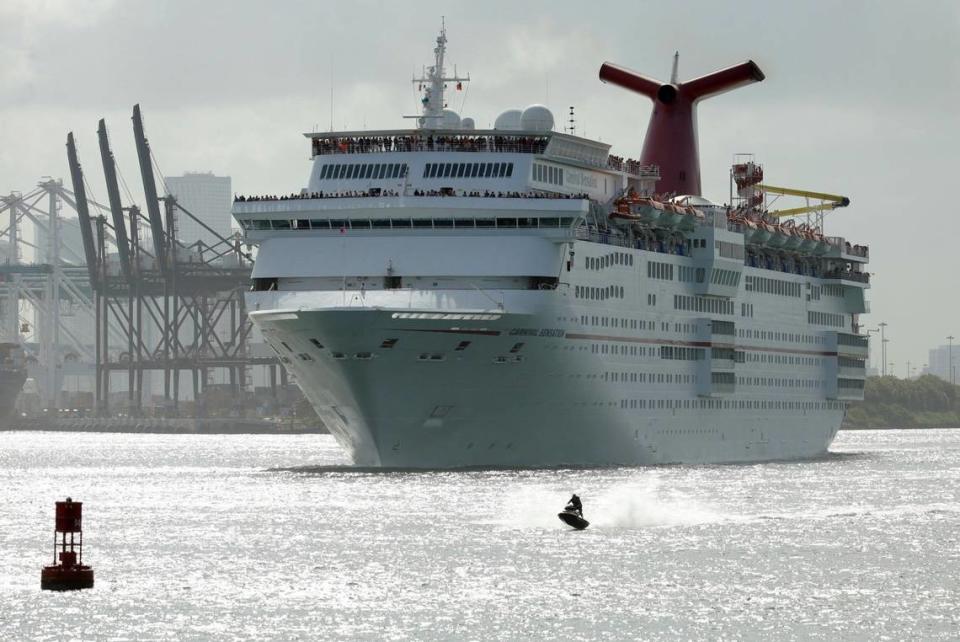PortMiami wants $285M in COVID rent breaks for cruise lines as debt pressures grow
Faced with a crippled cruise industry as a one-time cash cow, PortMiami wants to slash required rent payments for ships and hope business picks up in time to cover debt payments for an ongoing expansion.
The proposal before Miami-Dade commissioners Thursday would waive up to $285 million in fees Carnival, NCL, Royal Caribbean and other cruise companies would owe under minimum-rent deals they signed years ago to use the county-owned docks, terminals and garages off downtown Miami. The revenue is crucial to the port’s longtime financial viability, and its ability to make debt payments that otherwise must be covered by county tax dollars.
While the agreements require companies in the $35 billion cruise industry to pay the port millions of dollars in rent each year no matter how many passengers book cabins, the administration of Mayor Carlos Gimenez wants to forgive those payments as a way to keep Miami a cruising hub during the COVID recovery.
“Let’s face it — this beats not collecting anything, or ending up in court,” said Juan Kuryla, Gimenez’s port director. “This is all in the spirit of cooperation.”

The package up for a commission vote would formalize the rent freeze in effect now for a port where cruise lines haven’t been leaving with passengers since the spring. Gimenez waived fees at the start of the coronavirus crisis, and Kuryla said existing concessions and the planned rental breaks amount to about $55 million for most of 2020, plus another $13 million assuming ships start making cruises again before December.
Once federal regulators lift the existing “no sail” order on cruises, cruise lines would resume rental fees for ships, but not have to meet minimum payments. That switch would cost the port about $7 million a month, and last as long as two years.
Add it up and the waivers after the no-sail order is lifted would mean another $220 million in lost required revenue to the port, bringing the total relief to cruise lines to roughly $275 million, depending on whether the no-sail order lasts until next summer.
Some hope for cash from port garages
The agreement does have triggers to reduce the cost of the relief once the cruise market begins recovering. The existing agreements essentially created rent rebates by letting cruise lines keep parking revenues from terminal garages. The rent-relief package ends that perk, giving the port a source of cash if passengers begin returning with their vehicles. The port would also stop subsidizing cruse-line marketing campaigns with cash payments.
If business picks up, those changes could leave the port making more than it would under the existing arrangements and cruise lines would have the option of canceling the rent-relief agreements when they wanted.
Kuryla said the agreements were tailored to keep Miami poised to remain the top cruise port once ships begin filling up again, and reduce berthing costs enough for companies to consider leaving the port with vessels at a fraction of their normal capacity. The agreement bars cruise companies from using the waiver period to build up business elsewhere, requiring PortMiami to retain its share of each line’s bookings.
Port problems could mean taking taxes from police, parks
The stakes are high for a cruise recovery, since PortMiami has about $1.4 billion in debt and some of that must be covered by sales taxes and other general government funds if docking fees can’t cover the payments. Cruise revenues, including parking, made up about 58% of the port’s 2019 revenues, according to its most recent financial report, with cargo accounting for most of the rest of its $156 million in operating revenue.
Despite the coronavirus crisis, commissioners continued approving borrowing by the port. A September vote approved $335 million in new debt for cruise terminals and other projects, backed by property taxes and other governments for police, parks and transit if port revenues aren’t enough to cover the payments.
PortMiami needs cruise revenue to avoid a financial crisis, but not right away. The port has already spent $10 million of its cash reserves to cover costs, on top of $35 million in cost-cutting through 2020. It has about $115 million in cash reserves left, enough to cover bare-bones expenses and all debt payments until September 2022, according to Kuryla’s memo. He estimated the county would have to start spending reserves by April if cruising isn’t back by then.
Moody’s has a negative outlook on the port’s finances, and included some grim words in an August analysis of the county-owned facility’s austerity measures and long-term outlook.
“PortMiami will face difficult decisions to initiate additional cost reductions and postpone discretionary capital expenditures beyond fiscal 2020 if cruise revenue falls short of minimum annual revenue guarantees for an extended period of time,” the for-profit debt rater wrote. “The negative outlook reflects the uncertainty around the return of cruise operations in the US, the rapid deterioration in the credit quality of cruise lines as well as a high risk that minimum annual revenue guarantee contracts may be renegotiated.”

